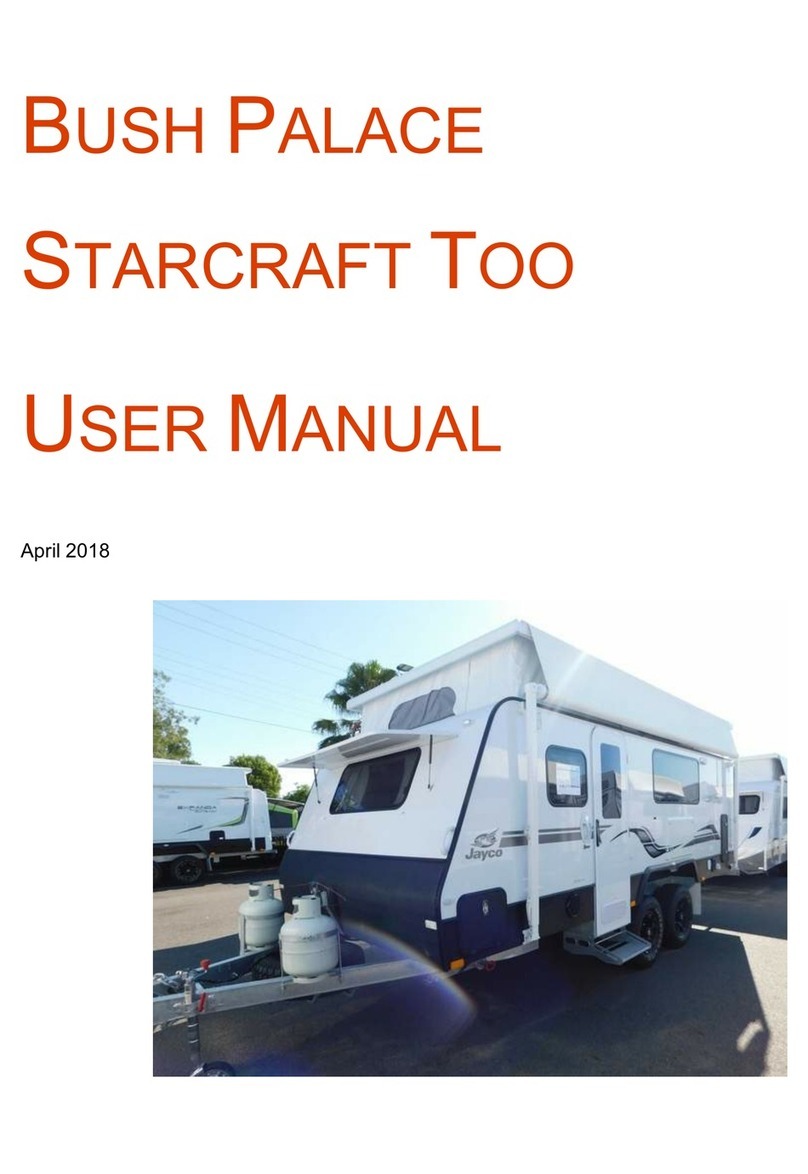CRIC KET® www.taxaoutdoors.com
1830 west 15th street houston, tx 77008 usa (rev.11292018) 9
LOADING
The process of safely and properly loading your trailer should become easier with practice and experience. Please first get familiar with and
understand the following terms related to your trailer’s weight, carrying capacity, and rating:
gross vehicle weight rating (GVWR) is the maximum permissible weight of the trailer when fully loaded and equipped/outfitted. It includes
but is not limited to all weight at the trailer axle(s) and tongue or pin as well as all add-ons, appliances, accessories, potable water, etc. Your
trailer’s GVWR is 2500 lbs. Please refer to the sticker located at the front exterior of your trailer for GVWR.
unloaded vehicle weight (UVW) is the weight of the trailer as manufactured at the factory (standard weight). It includes all weight at the
trailer axle(s) and tongue or pin. Your trailer’s standard UVW is approximately <1500 lbs. However, you will need to account for the weight
of dealer or third-party installed add-ons, options and accessories, if any, in determining your actual UVW. In sum, your actual UVW will
vary (and increase) to the extent you have outfitted your trailer with additional items. Note: Your cargo carrying capacity (discussed below)
will vary (and decrease) to the extent of the weight of dealer or third-party installed add-ons, options and accessories, if any.
cargo carrying capacity (CCC) is equal to GVWR minus UVW and potable water weight. Your trailer’s CCC is approximately 1000 lbs.
However, remember that your actual CCC will vary (and decrease) to the extent you have outfitted your trailer with additional items. Please
refer to the stickers located at the front exterior of your trailer for CCC.
gross axle weight rating (GAWR) is the value specified as the load carrying capacity of a single axle system, as measured at the tire-ground
interfaces. Your trailer’s GAWR is 2500 lbs. Please refer to the sticker located at the front exterior of your trailer for GAWR.
gross trailer weight (GTW) is the weight of the trailer with all the items and supplies that are loaded into the unit at any point in time.
WEIGHT GENERALLY
Before towing, you must choose the items you will load onto your trailer and then determine whether the loaded weight is safe and proper.
Of course, the best way (highly recommended) to calculate the loaded weight of your trailer is to have it weighed while loaded, and then
compare it with the GVWR (2500 lbs.). Otherwise, you will need to do some calculations on your own in order to make an appropriate
determination. If the loaded weight of your trailer exceeds the GVWR, your trailer is overloaded and should not be towed. You will need to
remove items from, and reduce the loaded weight of, the trailer until it’s at or below the GVWR before towing. Note: remember to include
in your calculations the weight of dealer or third-party installed equipment, options, add-ons, accessories and any other non-standard items.
As an additional safety precaution, we recommend that you take a conservative approach when doing your own weight calculations.
WEIGHT/LOAD DISTRIBUTION AND TONGUE WEIGHT
Proper weight and load distribution is essential to safe towing. Load the trailer evenly (front to back and side to side) and securely, keeping
heavier items as low as possible. Be sure to secure the load. A firmly secured load will be less prone to shifting and should help maintain
load balance during travel.
Tongue (the trailer arm extension that couples with the tow vehicle receiver) weight is the amount of weight borne by the trailer hitch and
another important consideration when loading your trailer. Generally, the actual tongue weight should equal approximately 10-15% of the
gross trailer weight. Excessive tongue weight will make your tow vehicle’s steering and braking less responsive. Insufficient tongue weight
may cause your trailer to sway.
You could weigh your loaded trailer's tongue to determine the actual tongue weight. However, you may also observe the actual tongue
weight and determine if it is too light or too heavy. For example, a trailer with a proper tongue weight will form a straight line from front to
back between the tow vehicle and the trailer. A trailer with the weight improperly distributed (i.e. a light tongue weight) will cause the
coupling between the tow vehicle and trailer to rise, with the weight pressing down at the rear of the trailer and the front of the tow vehicle.
Excessive tongue weight will do just the opposite.
If you notice a rise or fall in your tow coupling, you will need to redistribute the weight of the load before getting on the road. If you have
trouble estimating the combined weight of your trailer plus cargo, take your loaded trailer to a vehicle scale at a nearby weigh station or
truck stop. Important Note: you need to also refer to your tow vehicle’s towing capacity and other towing and load capacity-related definitions
and instructions before getting on the road. Please also consult your supplying dealer or Taxa Inc. if you have any questions regarding these
terms and/or loading your trailer.





























